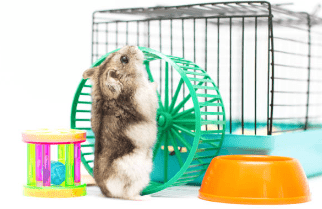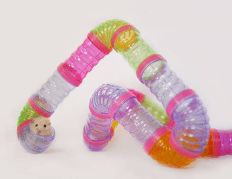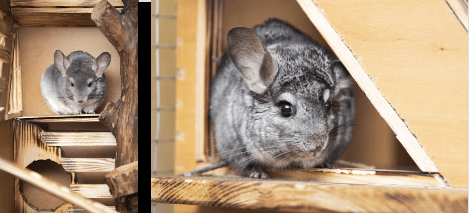So, you’ve got a chinchilla? Fantastic choice!
Having delved deep into the world of pets, I pride myself on my knack for crafting the ultimate havens. Let’s dive into chinchilla cage setups, shall we?
Your fluffy buddy deserves a cozy, stimulating space, and that starts with understanding its unique needs.
A splash of creativity, coupled with practical know-how, can lead you straight to a DIY chinchilla cage setup masterpiece.
Stay tuned for insider tips, tried-and-true advice, and of course, innovative chinchilla cage setup ideas that will inspire as well as DIY Chinchilla cage setup.
Ready to transform your pet’s space into a true chinchilla paradise?
Well, let’s get rolling!
Table of Contents
Understanding Chinchilla’s Needs and Behaviors
To truly appreciate and cater to our chinchilla pals, we must first dive deep into understanding their intrinsic behaviors and needs.
Originating from the rocky, mountainous regions of South America, chinchillas are accustomed to a unique set of environmental variables.
The Importance of a Properly Designed Cage Setup
Much like a person’s home reflects their personality, a chinchilla’s cage is a window into their world. A well-structured cage is not just about aesthetics or space; it’s about replicating their natural habitat to ensure they feel safe, stimulated, and satisfied.
Creating an Enriching Environment for Chinchillas
Beyond mere survival, chinchillas seek joy and engagement. To foster this, incorporate elements like climbing structures, interactive toys, and hideouts. A rich environment promotes mental stimulation, ensuring your chinchilla remains active, curious, and, most importantly, happy.
Planning Your Chinchilla Cage Setup
Crafting an ideal home for your chinchilla demands thoughtful planning and consideration of its inherent traits. By understanding their native environment, you can recreate a mini paradise for your furry friend.
Selecting the Right Cage Size and Material
When envisioning the cage, size does matter. Chinchillas are active creatures and require ample space to move and play. The material should be robust to withstand their gnawing tendencies while being non-toxic to ensure their safety.
Considering Vertical Space and Multiple Levels
Drawing inspiration from their mountainous origins, chinchillas adore vertical spaces. Multi-tiered cages not only offer them more room but also fulfill their love for climbing and exploring different elevations.
Choosing Safe and Comfortable Flooring
Wire-bottomed cages? A big no-no. Chinchillas need solid flooring to prevent foot injuries. Opt for easy-to-clean surfaces layered with comfy bedding, ensuring those little paws stay cushioned.
Planning Feeding Station and Bathroom Area

Organization is key. Designated areas for feeding and bathroom breaks keep the environment hygienic and ensure your chinchilla knows exactly where to go for meals and nature’s calls.
DIY Cage Setup Ideas and Projects
Creating a haven for your chinchilla can be a thrilling DIY adventure, merging functionality with creativity. Let’s channel your inner craftsman and craftswoman to tailor the ultimate chinchilla sanctuary.
Building Custom Wooden Platforms and Ledges
Wood, a classic and chinchilla-friendly material, makes for perfect platforms and ledges. Not only do they offer spots for perching and observing, but they also double as natural chew toys, satisfying your pet’s gnawing instincts.
Crafting Chinchilla-Safe Hammocks and Hanging Toys
Suspend some fun in their lives! Soft hammocks make cozy relaxation spots while hanging toys can introduce playful dynamics. Just ensure materials are non-toxic and threads can’t unravel.
Constructing DIY Chinchilla Hideouts and Tunnels

Everybody loves a secret hideaway. Use safe materials to build tunnels and hideouts, providing your chinchilla with a private retreat for rest and play.
Creating a Natural and Eco-Friendly Cage Decor
Embrace nature. Introducing plants (non-toxic ones, of course) and other organic materials can not only beautify the cage but also offer a more authentic habitat experience. Its aesthetics meet eco-friendliness in perfect harmony.
Essential Cage Accessories and Furniture
To turn your chinchilla’s cage into a lively dwelling, an array of accessories and furniture is pivotal. Think of these additions as the final touches to your pet’s luxury suite.
Chinchilla-Safe Hideouts and Sleeping Areas
A sanctuary within a sanctuary – every chinchilla deserves a private retreat. Crafted from non-toxic materials, these hideouts offer cozy corners for relaxation, ensuring your pet can always find a secluded spot to catch some Zs.
Providing a Variety of Chew Toys and Gnawing Materials
Gnawing isn’t just a hobby; it’s a chinchilla’s lifestyle. Offering an assortment of safe chew toys can engage them while also aiding in dental health. From wooden blocks to pumice stones, variety is the spice of their gnawing life.
Installing Exercise Wheels and Chinchilla-Sized Tunnels
Stay fit, stay fabulous! Exercise wheels tailored for chinchillas encourage physical activity, while tunnels inspire playful exploration. These are great for keeping your furry friend both entertained and fit.
Incorporating Climbing Structures and Platforms
Tap into their natural climbing instincts by integrating multi-level platforms and climbing structures. Not only will they enhance the cage’s visual appeal, but they’ll also provide ample opportunities for adventure.
Creating a Chinchilla-Friendly Play Area
Playtime is essential for chinchillas; it’s their Broadway, their Disneyland, their little world of wonders. Let’s ensure that their play area is both fun-filled and safe.
Designing a Safe and Secure Playpen
Crafting the ideal playpen means balancing freedom with safety. Opt for secure boundaries to prevent escapes and eliminate potential dangers. Soft edges, ample space, and chew-proof materials are your go-to elements. It’s about fun without the fuss.
Providing Interactive Toys and Games
The stage is set, but where’s the entertainment? Interactive toys and games keep boredom at bay. Consider mazes, puzzle toys, and even ball pits for those spirited romps. The joy of discovery, after all, is unparalleled.
Including Safe Chinchilla Dust Bathing Areas
A chinchilla’s spa day! Dust baths aren’t just a luxury; they’re a necessity for their fur care. Designate a spacious area in the playpen, filling it with chinchilla-specific dust.
Watch as your pet gleefully rolls and frolics, emerging fluffier and happier. It’s more than a bath; it’s a delightful ritual.
Temperature and Humidity Considerations
The ambient environment plays a critical role in a chinchilla’s well-being. Much like a thermostat for our comfort, chinchillas need their surroundings tweaked just right for them to thrive.
Maintaining Optimal Temperature Levels
Chinchillas don a thick fur coat, making them susceptible to overheating. Maintaining temperatures between 60-70°F (15-21°C) ensures they remain comfy and cool. Always monitor using a reliable cage thermometer.
Controlling Humidity for Chinchilla Comfort
High humidity? Think of it as a bad hair day for chinchillas. Ideal relative humidity levels lie between 40-60%. Consider using a dehumidifier or humidifier to achieve the right balance, ensuring their fur stays pristine and health intact.
Avoiding Drafts and Direct Sunlight Exposure
Chinchillas are like the Goldilocks of the rodent world; conditions must be “just right.” Position the cage away from drafty windows and direct sunlight. Both can lead to rapid temperature fluctuations. Providing a stable environment is your ticket to a chirpy, cheerful chinchilla.
Maintaining and Cleaning Your Chinchilla Cage
A tidy home is a happy home, especially in the chinchilla world. Regular maintenance not only ensures cleanliness but also amplifies your pet’s overall health and vitality.
Establishing a Cleaning Routine and Hygiene Practices
Routine is your best friend here. Weekly deep cleans, paired with daily spot checks, maintain optimal cage conditions. Remember to remove uneaten food, soiled bedding, and droppings daily, setting the stage for a happy chinchilla dance.
Using Safe and Non-Toxic Cleaning Products
For those deep cleans, opt for cleaners that are gentle on chinchillas but tough on dirt. Stay clear of harsh chemicals, instead choose mild, non-toxic, and unscented cleaning products. After all, a cage should smell like a home, not a laboratory.
Preventing Odors and Maintaining Freshness
Odor control goes hand in hand with cleanliness. Quality bedding, made from materials like aspen or recycled paper, effectively absorbs moisture and reduces smell.
Pair this with proper ventilation, and you’ve got yourself a fresh, inviting chinchilla haven. No nose-wrinkling allowed!
Safety Measures and Chinchilla Proofing
Safety first, always! In the world of chinchillas, curiosity doesn’t just kill the cat; it can pose risks to our fluffy friends too. Taking preventive measures ensures your chinchilla explores its surroundings without stumbling into trouble.
Ensuring Escape-Proof Cage Design
Chinchillas are adept escape artists with a knack for sneaky escapades. When choosing a cage, prioritize one with closely spaced bars to prevent any “Houdini” acts. Latches and locks should be sturdy and secure, ensuring they stay put and your mind stays at ease.
Securing Electrical Wires and Cords
Electrical cords seem like chew toys in the eyes of chinchillas, but, of course, they’re danger lurking in disguise. Use protective wraps or conduits to shield these cords, or better yet, keep them out of reach.
Not only does this step prevent potential shocks but also avoids damage to your appliances. A win-win, you might say.
Identifying and Removing Hazards
Chinchilla-proofing goes beyond the cage. Scour the room for possible threats. Small objects that can be ingested? Remove. Sharp or jagged edges? Cushion or cover. Potentially toxic plants or materials? Relocate.
Adopting a proactive stance, where you preemptively identify and address risks, lays the foundation for a safe chinchilla environment. And remember, in the pursuit of safety, it’s always better to be overly cautious than regretful.
Cage Maintenance and Safety Checks
Ensuring your chinchilla’s cage remains in tip-top shape is integral to their safety and well-being. A systematic approach to maintenance and routine safety checks is the key.
Here’s a simple guide:
- Regular Inspections: Examine the cage for wear and tear, especially the bars and latches. Over time, even sturdy cages can degrade.
- Bar Spacing: Ensure bars remain appropriately spaced to prevent escapes or head entrapments. Ideally, spacing should be no more than 1 inch.
- Locks and Latches: Double-check the efficiency of locks. If they show signs of rust or weakening, replace them promptly.
- Floor Integrity: Periodically inspect the cage floor. Any sagging, holes, or wear can be uncomfortable, or worse, hazardous.
- Water and Food Dispensers: Ensure food dispensers and water bottles are in working order. Regularly check for blockages, leaks, or any signs of mold.
- Toys and Accessories: Examine toys, hammocks, and other accessories for wear and tear. Replace anything that’s frayed, broken, or appears to be a choking hazard.
- Ventilation: Ensure the cage remains well-ventilated. Confirm that no toys, bedding, or other items obstruct critical airflow areas, which could lead to overheating.
- Emergency Kit: Always be one step ahead. Keep an emergency kit nearby with items tailored to chinchilla care, like first-aid materials and essential contact numbers.
By maintaining a routine checklist and performing regular safety checks, you’ll ensure your chinchilla’s home remains a haven, both comfortable and secure.
Conclusion
Crafting the ultimate chinchilla haven isn’t just about style—it’s about love, care, and understanding. By combining innovative DIY ideas with insights into your fluffy friend’s needs, you create more than just a cage; it’s a home.
Remember, a happy chinchilla means a vibrant, lively space. So, embark on this DIY journey, and witness the joy a thoughtfully-designed setup brings to your beloved pet. Cheers to chinchilla bliss!
FAQs
What materials are safe for a DIY chinchilla cage?
Use untreated wood, sturdy metals, and chew-proof plastics. Avoid materials with chemicals, sharp edges, or anything toxic when ingested.
How big should a DIY chinchilla cage be?
Ideally, a chinchilla cage should be spacious, with a minimum size of 24″ x 24″ x 36″, but bigger is always better, especially if it has multiple levels.
Can I use household items for chinchilla cage enrichment?
Yes, but ensure they’re safe and free from chemicals, sharp edges, and small parts that can be ingested. Common items include cardboard tubes and untreated wooden platforms.
Alina Hartley is a small-town girl with a ginormous love of bearded dragons. It all started with Winchester, a baby bearded who was abandoned at the shelter by his former owners because of a birth defect that caused one front leg to be shorter than the other. Alina originally went to the shelter looking for a guinea pig, but one look at Winchester and it was love at first sight. From that day on, Alina has dedicated her life to learning everything she can about bearded dragons. She loves helping new beardie parents start their incredible journey with these magnificent reptiles.
Follow her on:
LINKEDIN
TWITTER.
Read her latest articles HERE
Learn more about her HERE.

